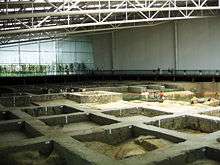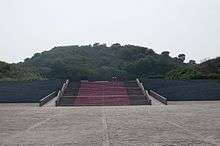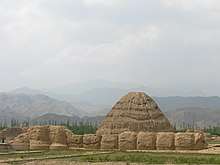National archaeological park of China
The national archaeological park (Chinese: 国家考古遗址公园) of China is a designation created by the State Administration of Cultural Heritage (SACH) in 2009 to preserve and present large-scale archaeological sites. National archaeological parks must have previously been designated as Major Historical and Cultural Sites Protected at the National Level, and are considered to have high historical, cultural, and academic value. They include ancient settlements, cities and towns, palaces, temples and caves, engineering and manufacturing sites, and mausoleums and cemeteries. Many parks also have on-site museums.[1]
The first 12 national archaeological parks were announced in 2010, and since then 24 more parks have been added to the list, bringing the total to 36. In addition, more than 60 sites have been designated as candidates for the national archaeological park status.[2][3][4]
Regulation
On 17 December 2009, the State Administration of Cultural Heritage issued the National Archaeological Park Administration Measures. According to the regulation, an archaeological site must meet five criteria before applying for national archaeological park status: it must be a Major Historical and Cultural Site Protected at the National Level; its provincial-level government has issued and implemented measures to protect the site; an archaeological work plan has been approved and commenced; has an archaeological park plan in compliance with the protection measures; has a specialized administration entity with corporate status.[5]
List of national archaeological parks
23 archaeological sites applied for the national archaeological park designation in 2010.[6] On 9 October 2010, the State Administration of Cultural Heritage (SACH) announced the first batch of 12 parks whose applications were approved.[2]
In December 2013, the SACH announced the second batch of 12 national archaeological parks.[3] In December 2017, the third batch of 12 national archaeological parks was announced, bringing the total to 36.[4]




| National archaeological park | Province | Batch |
|---|---|---|
| Old Summer Palace (Yuanmingyuan) | Beijing | 1 |
| Zhoukoudian (Peking Man site) | Beijing | 1 |
| Ji'an Gaogouli (Goguryeo) | Jilin | 1 |
| Hongshan | Jiangsu | 1 |
| Liangzhu | Zhejiang | 1 |
| Yinxu | Henan | 1 |
| Luoyang of Sui–Tang Dynasties | Henan | 1 |
| Sanxingdui | Sichuan | 1 |
| Jinsha | Sichuan | 1 |
| Han Yang Ling | Shaanxi | 1 |
| Mausoleum of the First Qin Emperor | Shaanxi | 1 |
| Daming Palace | Shaanxi | 1 |
| Niuheliang | Liaoning | 2 |
| Zhongjing of Bohai | Jilin | 2 |
| Shangjing of Bohai | Heilongjiang | 2 |
| Yuyaochang (Jingdezhen Imperial Kiln) | Jiangxi | 2 |
| Qufu, Capital of Lu | Shandong | 2 |
| Nanwang Hub of the Grand Canal | Shandong | 2 |
| Luoyang of Han–Wei Dynasties | Henan | 2 |
| Xiongjiazhong | Hubei | 2 |
| Tongguan Kiln | Hunan | 2 |
| Zengpiyan | Guangxi | 2 |
| Diaoyucheng | Chongqing | 2 |
| Beiting City | Xinjiang | 2 |
| Zhongdu of Yuan | Hebei | 3 |
| Dayao Longquan Kilns | Zhejiang | 3 |
| Shanglin Lake Yue Kilns | Zhejiang | 3 |
| Zhongdu of Ming | Anhui | 3 |
| Wanshouyan | Fujian | 3 |
| Chengziya | Shandong | 3 |
| Jizhou Kiln | Jiangxi | 3 |
| Zheng–Han City | Henan | 3 |
| Panlongcheng | Hubei | 3 |
| Chengtoushan | Hunan | 3 |
| Weiyang Palace | Shaanxi | 3 |
| Western Xia Mausoleums | Ningxia | 3 |
Candidate parks
In addition to the approved parks, the SACH has also given a number of parks the status of "candidate national archaeological parks". When announcing the first batch of 12 approved parks, it also announced 23 candidate parks,[2] of which 11 were later approved in the second batch announced in 2013.[3]
- Jinyang City, Shanxi
- Niuheliang, Liaoning (approved in the second batch)
- Zhongjing of Bohai, Jilin (approved in the second batch)
- Yangzhou City, Jiangsu
- Yuyaochang (Jingdezhen Imperial Kiln), Jiangxi (approved in the second batch)
- Nanwang Hub of the Grand Canal, Shandong (approved in the second batch)
- Qufu, Capital of Lu, Shandong (approved in the second batch)
- Dawenkou, Shandong
- Luoyang of Han-Wei Dynasties, Henan (approved in the second batch)
- Zhengzhou Shang City, Henan
- Sanyangzhuang, Henan
- Jinancheng (including Balingshan and Xiongjiazhong), Hubei (Xiongjiazhong approved in the second batch)
- Tongguan Kiln, Hunan (approved in the second batch)
- Liye Ancient City, Hunan
- Laosicheng, Hunan
- Jingjiang Princes' Palace and Mausoleums, Guangxi
- Zengpiyan, Guangxi (approved in the second batch)
- Kele, Guizhou
- Chang'an of Han, Shaanxi
- Xianyang of Qin, Shaanxi
- Suoyang City, Gansu
- Beiting City, Xinjiang (approved in the second batch)
- Diaoyucheng, Chongqing (approved in the second batch)
31 candidate parks were announced together with the second batch of approved parks in 2013,[3] of which 9 were later approved in the third batch announced in 2017.[4]
- Zhongdu of Yuan, Hebei 元中都 (approved in the third batch)
- Nihewan, Hebei
- Zhaowangcheng, Hebei 赵王城
- Pujindu and Puzhou City, Shanxi 蒲津渡与蒲州故城
- Shangjing of Liao, Inner Mongolia 辽上京
- Salawusu, Inner Mongolia 萨拉乌苏
- Jinniushan, Liaoning
- Luotong Mountain City, Jilin 罗通山城
- Shangjing of Jin, Heilongjiang 金上京
- Helü City, Jiangsu 阖闾城
- Lingjiatan, Anhui 凌家滩
- Zhongdu of Ming, Anhui 明中都皇故城 (approved in the third batch)
- Chengcun Han City, Fujian 城村汉城
- Wanshouyan, Fujian 万寿岩 (approved in the third batch)
- Jizhou Kiln, Jiangxi 吉州窑 (approved in the third batch)
- Linzi, Capital of Qi, Shandong
- Chengziya, Shandong (approved in the third batch)
- Zheng–Han City, Henan 郑韩故城 (approved in the third batch)
- Yanshi Shang City, Henan 偃师商城
- Chengyang City, Henan 城阳城址
- Tonglüshan, Hubei 铜绿山
- Longwan, Hubei 龙湾
- Panlongcheng, Hubei (approved in the third batch)
- Tanheli, Hunan 炭河里
- Chengtoushan, Hunan (approved in the third batch)
- Taihe City, Yunnan 太和城
- Tongwancheng, Shaanxi
- Longgangsi, Shaanxi 龙岗寺
- Dadiwan, Gansu 大地湾
- Western Xia Mausoleums, Ningxia (approved in the third batch)
- Lajia, Qinghai
In December 2017, 32 candidate parks were announced together with the third batch of approved parks.[4]
- Capital of the Zhongshan Kingdom, Hebei
- Yecheng, Hebei
- Taosi, Shanxi
- Tuchengzi, Inner Mongolia
- Mopancun Mountain City, Jilin
- Longqiuzhuang, Jiangsu
- Majiabang, Zhejiang
- Anji Ancient City and Longshan Yue Cemetery, Zhejiang
- Shouchun City, Anhui
- Shuangdun, Bengbu, Anhui
- Yuhuicun, Anhui
- Wucheng, Jiangxi
- Marquisate of Haihun, Jiangxi
- Liangchengzhen, Shandong
- Yangshao, Henan
- Erlitou, Henan
- Jiahu, Henan
- Miaodigou, Henan
- Dahecun, Henan
- Qujialing, Hubei
- Shijiahe, Hubei
- Sujialong 苏家垄, Hubei
- Bijiashan Chaozhou Kiln, Guangdong
- Tomb of Francis Xavier and Dazhouwan, Guangdong
- Hepu Han City and Cemetery, Guangxi
- Qiong Kiln, Sichuan
- Qianling Mausoleum, Shaanxi
- Epang Palace, Shaanxi
- Zhouyuan, Shaanxi
- Duling Mausoleum, Shaanxi
- Shimao, Shaanxi
- Subashi Temple, Xinjiang
References
- Xu Guangji 徐光冀 (29 February 2016). "大遗址保护与国家考古遗址公园" (in Chinese). Institute of Archaeology, Chinese Academy of Social Sciences.
- "文物局公布首批国家考古遗址公园名单和立项名单" (in Chinese). State Administration of Cultural Heritage. 9 October 2010.
- "关于公布第二批国家考古遗址公园名单和立项名单的通知" (in Chinese). State Administration of Cultural Heritage. 18 December 2013.
- "第三批国家考古遗址公园立项名单公布:共32个,含海昏侯国". Thepaper.cn (in Chinese). 3 December 2017.
- "文物局发布国家考古遗址公园管理办法(试行)" (in Chinese). National People's Congress. 7 January 2010.
- Gregory, David, ed. (5 July 2017). Preserving Archaeological Remains in Situ: Proceedings of the 4th International Conference. Taylor & Francis. p. 263. ISBN 978-1-351-55330-8.